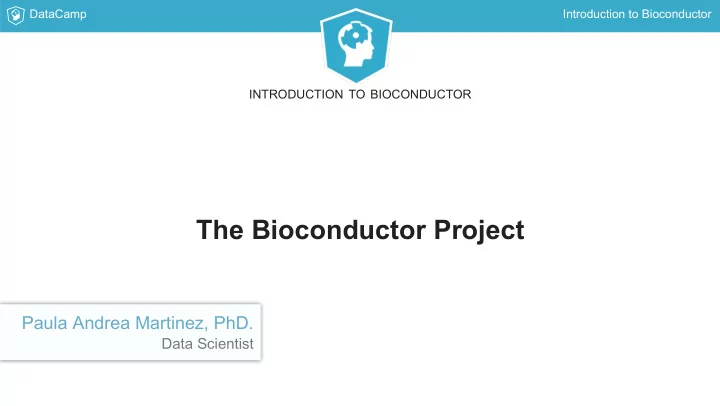

DataCamp Introduction to Bioconductor INTRODUCTION TO BIOCONDUCTOR The Bioconductor Project Paula Andrea Martinez, PhD. Data Scientist
DataCamp Introduction to Bioconductor Bioconductor [1] Bioconductor (www.bioconductor.org)
DataCamp Introduction to Bioconductor What do we measure and why? Structure : elements, regions, size, order, relationships Function : expression, levels, regulation, phenotypes
DataCamp Introduction to Bioconductor How to install Bioconductor packages? Biconductor has its own repository, way to install packages, and each release is designed to work with a specific version of R. For this course, you'll be using Bioconductor version 3.6. Bioconductor version 3.7 or earlier uses BiocLite : source("https://bioconductor.org/biocLite.R") biocLite("packageName") Bioconductor version 3.8 and later uses BiocManager : if (!requireNamespace("BiocManager")) install.packages("BiocManager") BiocManager::install()
DataCamp Introduction to Bioconductor Bioconductor version and package version BiocInstaller works for Bioconductor version 3.7 or earlier # Check Bioconductor version (For versions <= 3.7) BiocInstaller::biocVersion() # or biocVersion() # Load a package library(packageName) # Check versions for reproducibility sessionInfo() # or packageVersion("packageName") # Check package updates (Bioconductor version <= 3.7) BiocInstaller::biocValid() # or biocValid()
DataCamp Introduction to Bioconductor INTRODUCTION TO BIOCONDUCTOR Let's practice!
DataCamp Introduction to Bioconductor INTRODUCTION TO BIOCONDUCTOR The Role of S4 in Bioconductor Paula Andrea Martinez, PhD. Data Scientist
DataCamp Introduction to Bioconductor S3 Positive CRAN, simple but powerful Flexible and interactive Uses a generic function Functionality depends on the first argument Example: plot() and methods(plot) Negative Bad at validating types and naming conventions (dot not dot?) Inheritance works, but depends on the input
DataCamp Introduction to Bioconductor S4 Positive Formal definition of classes Bioconductor reusability Has validation of types Naming conventions Example: mydescriptor <- new("GenomeDescription") Negative Complex structure compared to S3
DataCamp Introduction to Bioconductor Is it S4 or not? Ask if an object is S4 isS4(mydescriptor) [1] TRUE str of S4 objects start with Formal class str(mydescriptor) Formal class 'GenomeDescription' [package "GenomeInfoDb"] with 7 slots ...
DataCamp Introduction to Bioconductor S4 class definition A class describes a representation name slots (methods/fields) contains (inheritance definition) Example MyEpicProject <- setClass(# Define class name with UpperCamelCase "MyEpicProject", # Define slots, helpful for validation slots = c(ini = "Date", end = "Date", milestone = "character"), # Define inheritance contains = "MyProject")
DataCamp Introduction to Bioconductor S4 Accesors .S4methods(class = "GenomeDescription") [1] commonName organism provider providerVersion [5] releaseDate releaseName seqinfo seqnames [9] show toString bsgenomeName showMethods(classes = "GenomeDescription", where = search()) Object summary show(myDescriptor) | organism: () | provider: | provider version: | release date: | release name: | --- | seqlengths:
DataCamp Introduction to Bioconductor INTRODUCTION TO BIOCONDUCTOR Let's practice!
DataCamp Introduction to Bioconductor INTRODUCTION TO BIOCONDUCTOR Introducing biology of genomic datasets Paula Andrea Martinez, PhD. Data Scientist
DataCamp Introduction to Bioconductor
DataCamp Introduction to Bioconductor
DataCamp Introduction to Bioconductor Genome elements Genetic information DNA alphabet A set of chromosomes (highly variable number) Genes (carry heredity instructions) coding and non-coding Proteins (responsible for specific functions) DNA-to-RNA (transcription) RNA-to-protein (translation)
DataCamp Introduction to Bioconductor Yeast A single cell microorganism The fungus that people love ❤ Used for fermentation: beer, bread, kefir, kombucha, bioremediation, etc. Name: Saccharomyces cerevisiae or S. cerevisiae
DataCamp Introduction to Bioconductor Yeast genome BSgenome annotation package # load the package and store data into yeast library(BSgenome.Scerevisiae.UCSC.sacCer3) yeast <- BSgenome.Scerevisiae.UCSC.sacCer3 #interested in other genomes? available.genomes() Using accessors # Chromosome number length(yeast) # Chromosome names names(yeast) # Sequence lengths seqlengths(yeast)
DataCamp Introduction to Bioconductor Get sequences S4 method for BSgenome # S4 method getSeq() requires a BSgenome object getSeq(yeast) # Select chromosome sequence by name, one or many getSeq(yeast, "chrM") # Select start, end and or width # end = 10, selects first 10 base pairs of each chromosome getSeq(yeast, end = 10)
DataCamp Introduction to Bioconductor INTRODUCTION TO BIOCONDUCTOR Let's practice!
Recommend
More recommend